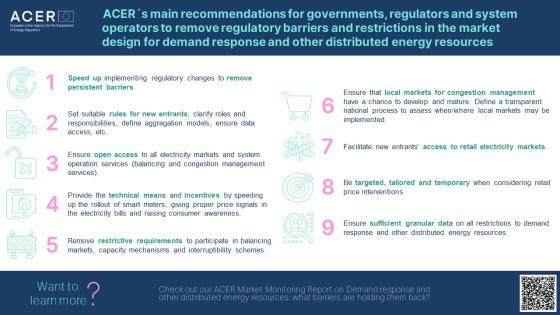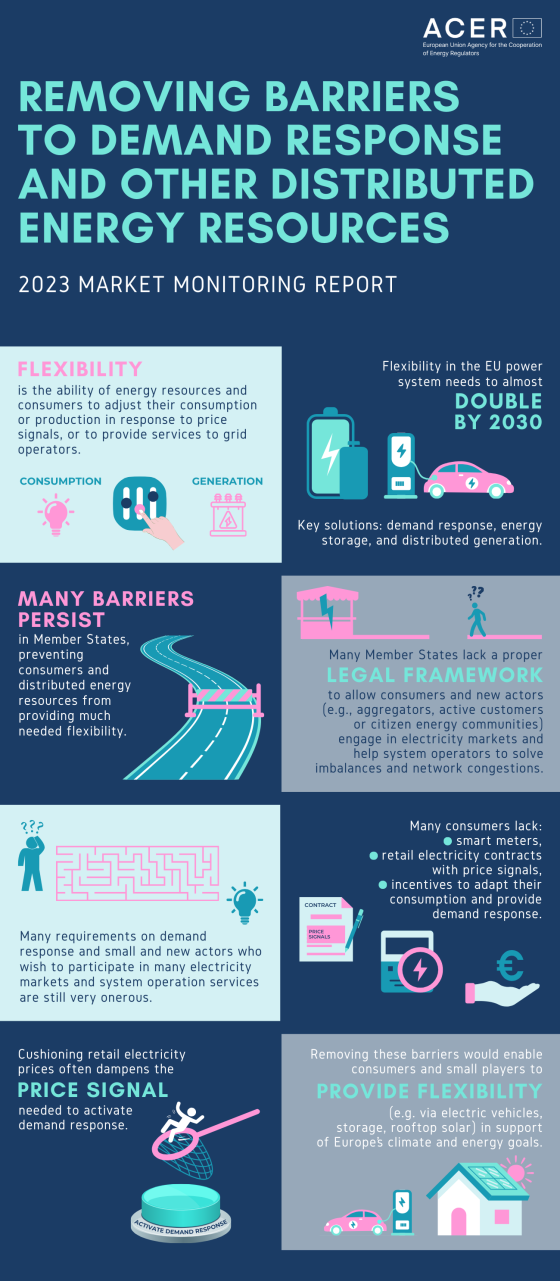ACER offers a to-do list to remove the barriers that hinder demand response, new entrants and small players

ACER offers a to-do list to remove the barriers that hinder demand response, new entrants and small players
What is it about?
Today, ACER publishes its report on monitoring the barriers to demand response and other distributed energy resources, which is part of the 2023 Market Monitoring Report (MMR) series.
ACER makes specific recommendations that can help governments, regulators and network operators to remove the barriers that are holding back demand response and distributed energy resources in their countries. Removing these barriers would enable consumers and small players (e.g. electric vehicles, new storage solutions, rooftop solar) to actively participate in the electricity markets and help system operators to solve imbalances and network congestions providing much needed flexibility in support of Europe’s climate and energy goals.
What is the ACER report about?
This report identifies the main regulatory barriers and market restrictions that hindered the participation of distributed energy resources (i.e., demand response, energy storage and distributed generation) in the European wholesale electricity markets and system operation services in 2022.
Why is it so critical to leverage energy savings and small energy players?
The recent energy crisis showed how shifting and reducing electricity demand plays a crucial role when electricity supply is scarce or at risk. Europe’s ambition to be a carbon neutral continent by 2050 also means that a massive rollout of renewables is needed. Flexibility in the power system must double to keep pace with renewables. As the supply side increasingly fluctuates (with variable renewables) one important source of flexibility is the electricity consumers (also called “demand side”) and other small and distributed resources (e.g. batteries or rooftop solar).
The European Commission’s assessment of the draft updated National Energy and Climate Plans (18 December 2023) points out that going forward, the demand side of the electricity sector and energy storage are insufficiently covered despite the growing importance of flexibility.
What are the key findings of ACER’s barriers to demand response report?
- Many barriers to demand response persist (e.g. difficulties to access markets, lack of national rules, some retail electricity prices do not send proper price signals, etc.). Collectively, these significantly impact the market. Incentivising demand response should remain a priority for policy makers.
- Price spikes signal opportunities: price spikes and negative prices are more and more frequent, sending clear signals on when and where there is a need to increase supply or cut or shift demand.
- A proper legal framework for new actors to enter the electricity markets and system operation services is still missing in many Member States.
- Many consumers still need smart meters and incentivising retail electricity contracts to cut or shift their energy consumption.
- There is limited participation of distributed energy resources (e.g. consumers or batteries) in balancing services, congestion management services and capacity mechanisms.
- Some retail markets are not sufficiently open to new actors and competition.
- Some retail price interventions dampen price signals needed to activate demand response. On top of the price interventions introduced as emergency measures in response to the energy crisis, at least thirteen Member States have interventions in the retail electricity prices that predated the energy crisis. Most do not provide signals for demand response activation.
- Since 2020, some progress has been made in several countries (e.g. improving their national legislation, relaxing some requirements to provide balancing services or making their capacity mechanisms more inclusive).
What are ACER’s recommendations?
The ACER report presents key findings and specific recommendations. Broadly, this includes 9 recommendations to Member States, regulators, transmission system operators and distribution system operators, including to:
- Speed up implementing regulatory changes to remove persistent barriers to electricity consumers and other new entrants and small players.
- Accelerate the roll-out of smart meters, provide proper price signals in electricity bills contracts and raise consumer awareness to activate demand response.
- Ensure that local markets for congestion management have a chance to develop and mature. Define a transparent national process to assess when/where local markets may be implemented.
- Facilitate new entrants’ access to retail energy markets.
- Be targeted, tailored and temporary when considering retail price interventions.
In line with the ACER-EEA’s flexibility report (published in October 2023), ACER also recommends that Member States collaborate to unlock flexibility and enhance security of supply, while also supporting long-term goals for climate neutrality.
What are the next steps?
From 19 December 2023 until 2 February 2024 ACER is running a public consultation to gather inputs on the prioritisation of strategies for overcoming barriers to demand response.
On 19 January 2024, ACER will also organise a webinar to present its report on barriers to demand response and discuss with stakeholders.


